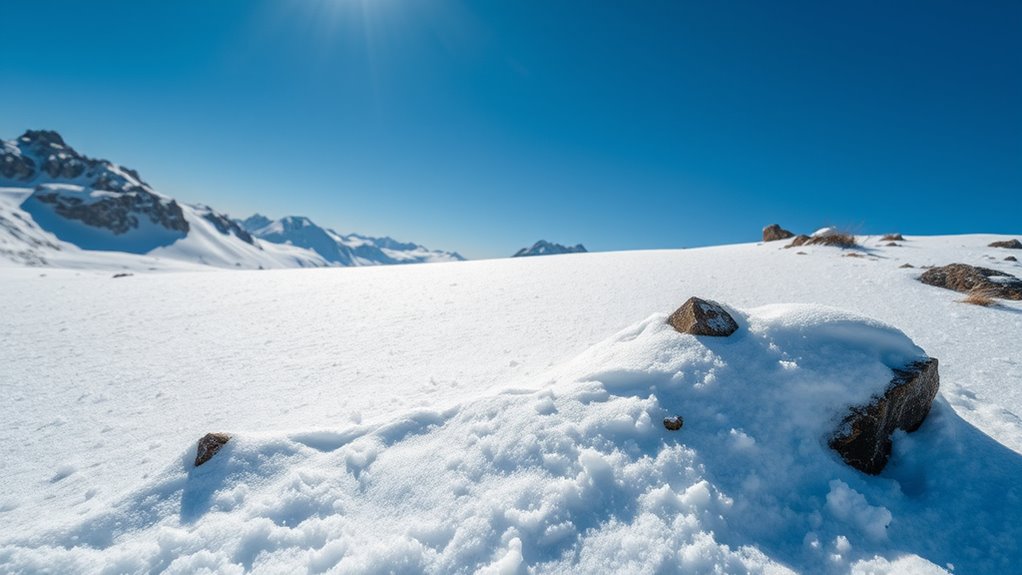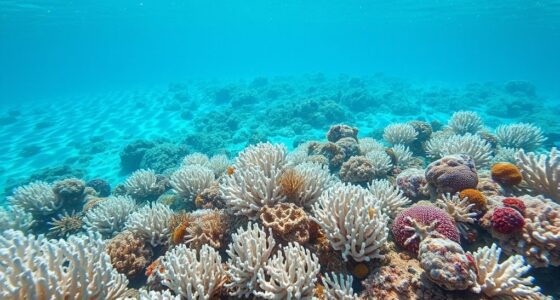Microplastics are now found in remote mountain snow, showing how pollution travels globally through the atmosphere. Tiny particles from urban waste, vehicle emissions, and industry become airborne and hitch rides on wind currents, reaching even the most isolated regions. As snow melts, it releases these microplastics into ecosystems, spreading pollution further. This cycle highlights how human activities impact distant environments. If you keep exploring, you’ll uncover more about how this interconnected process unfolds worldwide.
Key Takeaways
- Microplastics are found in remote mountain snow, indicating widespread atmospheric dispersal beyond urban areas.
- Wind currents transport microplastics from pollution sources to high-altitude and isolated environments.
- Melting snow releases accumulated microplastics into ecosystems, perpetuating environmental contamination.
- The presence of microplastics in snow reflects a global cycle involving urban waste, atmospheric transport, and environmental deposition.
- Addressing this cycle requires controlling pollution sources and understanding atmospheric pathways of microplastic dispersal.

Recent studies reveal that microplastics are increasingly contaminating mountain snow, even in remote areas once thought to be untouched by pollution. This alarming trend highlights how urban pollution isn’t confined to cities; instead, it travels through the atmosphere, reaching the most isolated environments. You might imagine mountains as pristine, but atmospheric transport ensures microplastics can hitch a ride on wind currents and settle far from their original sources. When you consider how tiny these particles are—less than 5 millimeters—they can easily become airborne and drift over great distances, bypassing traditional pollution barriers.
Microplastics from urban areas travel through the atmosphere, contaminating even the most remote mountain snowfields.
Understanding this process helps explain the widespread presence of microplastics in mountain snow. Urban pollution, primarily from plastic waste, vehicle emissions, and industrial activity, generates countless microplastic particles. These particles become airborne through various mechanisms—wear and tear of tires, degradation of plastic debris, and even household dust. Once airborne, prevailing winds carry these particles into higher altitudes and remote regions. The atmosphere acts like a conveyor belt, transporting microplastics from densely populated areas to the most secluded mountain ranges. This atmospheric transport doesn’t discriminate; it disperses microplastics globally, effectively turning even the highest, most remote snowfields into repositories.
As you look closer at this phenomenon, you realize that the microplastics don’t just settle on the snow’s surface. They can become embedded within the snowpack, later released during melting periods. This means that mountain snow acts as both a sink and a source, releasing microplastics into downstream ecosystems and water supplies. The effects ripple beyond the mountains, impacting aquatic life and human communities reliant on clean water. The presence of microplastics in snow signals a larger cycle of pollution—one where urban waste and atmospheric transport combine to infiltrate natural environments with plastics.
In essence, the contamination of mountain snow by microplastics underscores how interconnected our environment truly is. No longer can you think of pollution as only local; it’s part of a global cycle driven by human activity and atmospheric dynamics. The invisible journey of microplastics from city streets through the air into remote mountain peaks reveals how pollution’s reach has expanded. It’s a reminder that addressing this problem requires understanding and managing the sources of urban pollution, along with mitigating how these tiny particles travel through the atmosphere, spreading far beyond their origins.
Frequently Asked Questions
How Do Microplastics Affect Mountain Ecosystems Long-Term?
You might wonder how microplastics impact mountain ecosystems long-term. They cause soil contamination, disrupting nutrient cycles and harming microorganisms essential for plant growth. Microplastics can also be taken up by plants through root systems, affecting their health and the animals that depend on them. Over time, these effects may weaken ecosystem resilience, reduce biodiversity, and threaten the delicate balance of mountain environments you cherish and rely on.
Can Microplastics in Snow Harm Human Health Directly?
Think of microplastics in snow as tiny poison darts waiting to strike. While direct health risks from ingesting snow are low, you should be aware of potential ingestion concerns if contaminated snow melts and enters your water supply. These microplastics could carry harmful chemicals, posing long-term health risks. So, while immediate danger’s slim, the accumulation might quietly impact your health over time, like a slow drip of poison.
What Are the Primary Sources of Microplastics Reaching Mountains?
You might wonder where microplastics in mountains come from. They primarily reach these remote areas through atmospheric deposition, where tiny particles are carried by wind from cities and industrial zones. Urban runoff also contributes, as microplastics wash into waterways and eventually drift into mountain snow. These processes combine to transport microplastics over long distances, making it a global issue that impacts even the most secluded mountain environments.
Are Mountain Microplastic Levels Increasing Over Time Globally?
You’re wondering if mountain microplastic levels are rising globally. Evidence suggests they are, driven by urban pollution and climate change. As urban areas emit more plastics and atmospheric currents transport microplastics to higher elevations, levels increase over time. Climate change also accelerates snow melt, releasing stored microplastics. So, yes, mountain microplastic contamination is likely growing, reflecting broader environmental challenges and the need for stronger pollution controls.
How Can Communities Mitigate Microplastic Contamination in Mountain Regions?
Mitigating microplastic contamination in mountain regions begins with your community’s commitment. You can foster community engagement by organizing cleanup campaigns, spreading awareness, and encouraging sustainable habits. Supporting strong policy implementation guarantees regulations limit plastic waste and reduce pollution. Together, your community can create a clean, clear, and conserved mountain environment, turning efforts into eco-friendly action and making a meaningful difference in safeguarding natural beauty from microscopic messes.
Conclusion
As you can see, microplastics in mountain snow reveal how interconnected our world truly is. They travel vast distances, impacting even the most remote places. Remember, “a chain is only as strong as its weakest link,” so reducing plastic waste everywhere helps protect these pristine environments. By staying mindful of your choices, you can contribute to breaking this cycle and preserving nature’s beauty for generations to come.









